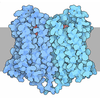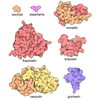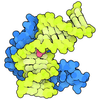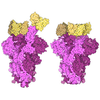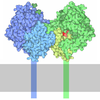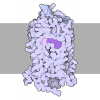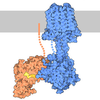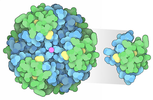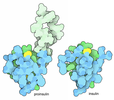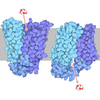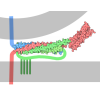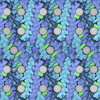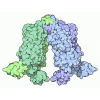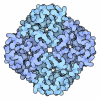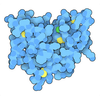[English] 日本語
 Yorodumi
Yorodumi- PDB-7jvr: Cryo-EM structure of Bromocriptine-bound dopamine receptor 2 in c... -
+ Open data
Open data
- Basic information
Basic information
| Entry | Database: PDB / ID: 7jvr | ||||||||||||||||||||||||||||||||||||
|---|---|---|---|---|---|---|---|---|---|---|---|---|---|---|---|---|---|---|---|---|---|---|---|---|---|---|---|---|---|---|---|---|---|---|---|---|---|
| Title | Cryo-EM structure of Bromocriptine-bound dopamine receptor 2 in complex with Gi protein | ||||||||||||||||||||||||||||||||||||
 Components Components |
| ||||||||||||||||||||||||||||||||||||
 Keywords Keywords | SIGNALING PROTEIN / Dopamine receptor 2 / Gi protein / bromocriptine | ||||||||||||||||||||||||||||||||||||
| Function / homology |  Function and homology information Function and homology informationnegative regulation of dopamine receptor signaling pathway / positive regulation of dopamine uptake involved in synaptic transmission / negative regulation of dephosphorylation / positive regulation of glial cell-derived neurotrophic factor production / acid secretion / dopamine neurotransmitter receptor activity, coupled via Gi/Go / nervous system process involved in regulation of systemic arterial blood pressure / response to histamine / negative regulation of circadian sleep/wake cycle, sleep / regulation of synapse structural plasticity ...negative regulation of dopamine receptor signaling pathway / positive regulation of dopamine uptake involved in synaptic transmission / negative regulation of dephosphorylation / positive regulation of glial cell-derived neurotrophic factor production / acid secretion / dopamine neurotransmitter receptor activity, coupled via Gi/Go / nervous system process involved in regulation of systemic arterial blood pressure / response to histamine / negative regulation of circadian sleep/wake cycle, sleep / regulation of synapse structural plasticity / regulation of locomotion involved in locomotory behavior / neuron-neuron synaptic transmission / adenohypophysis development / negative regulation of dopamine secretion / positive regulation of renal sodium excretion / negative regulation of cellular response to hypoxia / hyaloid vascular plexus regression / adenylate cyclase-inhibiting dopamine receptor signaling pathway / orbitofrontal cortex development / cerebral cortex GABAergic interneuron migration / response to inactivity / regulation of potassium ion transport / Dopamine receptors / negative regulation of neuron migration / dopamine binding / branching morphogenesis of a nerve / regulation of dopamine uptake involved in synaptic transmission / phospholipase C-activating dopamine receptor signaling pathway / positive regulation of growth hormone secretion / peristalsis / heterotrimeric G-protein binding / drinking behavior / G protein-coupled receptor complex / grooming behavior / behavioral response to ethanol / auditory behavior / positive regulation of G protein-coupled receptor signaling pathway / striatum development / dopaminergic synapse / positive regulation of urine volume / positive regulation of multicellular organism growth / G protein-coupled receptor internalization / non-motile cilium / heterocyclic compound binding / negative regulation of synaptic transmission, glutamatergic / response to iron ion / adult walking behavior / arachidonate secretion / response to morphine / ciliary membrane / negative regulation of cytosolic calcium ion concentration / temperature homeostasis / regulation of synaptic transmission, GABAergic / positive regulation of neuroblast proliferation / pigmentation / positive regulation of cytokinesis / dopamine metabolic process / dopamine uptake involved in synaptic transmission / regulation of dopamine secretion / cellular response to ethanol / response to light stimulus / associative learning / positive regulation of receptor internalization / lateral plasma membrane / neuroblast proliferation / endocytic vesicle / G-protein alpha-subunit binding / negative regulation of protein secretion / long-term memory / potassium channel regulator activity / sperm flagellum / prepulse inhibition / response to axon injury / postsynaptic modulation of chemical synaptic transmission / adenylate cyclase inhibitor activity / synapse assembly / positive regulation of protein localization to cell cortex / negative regulation of blood pressure / regulation of sodium ion transport / T cell migration / Adenylate cyclase inhibitory pathway / behavioral response to cocaine / cellular response to retinoic acid / D2 dopamine receptor binding / response to prostaglandin E / release of sequestered calcium ion into cytosol / adenylate cyclase regulator activity / G protein-coupled serotonin receptor binding / axon terminus / ionotropic glutamate receptor binding / adenylate cyclase-inhibiting serotonin receptor signaling pathway / presynaptic modulation of chemical synaptic transmission / acrosomal vesicle / negative regulation of phosphatidylinositol 3-kinase/protein kinase B signal transduction / cellular response to forskolin / axonogenesis / regulation of heart rate / negative regulation of innate immune response / negative regulation of cell migration / regulation of mitotic spindle organization Similarity search - Function | ||||||||||||||||||||||||||||||||||||
| Biological species |   Homo sapiens (human) Homo sapiens (human)synthetic construct (others) | ||||||||||||||||||||||||||||||||||||
| Method | ELECTRON MICROSCOPY / single particle reconstruction / cryo EM / Resolution: 2.8 Å | ||||||||||||||||||||||||||||||||||||
 Authors Authors | Zhuang, Y. / Xu, P. / Mao, C. / Wang, L. / Krumm, B. / Zhou, X.E. / Huang, S. / Liu, H. / Cheng, X. / Huang, X.-P. ...Zhuang, Y. / Xu, P. / Mao, C. / Wang, L. / Krumm, B. / Zhou, X.E. / Huang, S. / Liu, H. / Cheng, X. / Huang, X.-P. / Sheng, D.-D. / Xu, T. / Liu, Y.-F. / Wang, Y. / Guo, J. / Jiang, Y. / Jiang, H. / Melcher, K. / Roth, B.L. / Zhang, Y. / Zhang, C. / Xu, H.E. | ||||||||||||||||||||||||||||||||||||
| Funding support |  China, China,  United States, 4items United States, 4items
| ||||||||||||||||||||||||||||||||||||
 Citation Citation |  Journal: Cell / Year: 2021 Journal: Cell / Year: 2021Title: Structural insights into the human D1 and D2 dopamine receptor signaling complexes. Authors: Youwen Zhuang / Peiyu Xu / Chunyou Mao / Lei Wang / Brian Krumm / X Edward Zhou / Sijie Huang / Heng Liu / Xi Cheng / Xi-Ping Huang / Dan-Dan Shen / Tinghai Xu / Yong-Feng Liu / Yue Wang / ...Authors: Youwen Zhuang / Peiyu Xu / Chunyou Mao / Lei Wang / Brian Krumm / X Edward Zhou / Sijie Huang / Heng Liu / Xi Cheng / Xi-Ping Huang / Dan-Dan Shen / Tinghai Xu / Yong-Feng Liu / Yue Wang / Jia Guo / Yi Jiang / Hualiang Jiang / Karsten Melcher / Bryan L Roth / Yan Zhang / Cheng Zhang / H Eric Xu /   Abstract: The D1- and D2-dopamine receptors (D1R and D2R), which signal through G and G, respectively, represent the principal stimulatory and inhibitory dopamine receptors in the central nervous system. D1R ...The D1- and D2-dopamine receptors (D1R and D2R), which signal through G and G, respectively, represent the principal stimulatory and inhibitory dopamine receptors in the central nervous system. D1R and D2R also represent the main therapeutic targets for Parkinson's disease, schizophrenia, and many other neuropsychiatric disorders, and insight into their signaling is essential for understanding both therapeutic and side effects of dopaminergic drugs. Here, we report four cryoelectron microscopy (cryo-EM) structures of D1R-G and D2R-G signaling complexes with selective and non-selective dopamine agonists, including two currently used anti-Parkinson's disease drugs, apomorphine and bromocriptine. These structures, together with mutagenesis studies, reveal the conserved binding mode of dopamine agonists, the unique pocket topology underlying ligand selectivity, the conformational changes in receptor activation, and potential structural determinants for G protein-coupling selectivity. These results provide both a molecular understanding of dopamine signaling and multiple structural templates for drug design targeting the dopaminergic system. | ||||||||||||||||||||||||||||||||||||
| History |
|
- Structure visualization
Structure visualization
| Movie |
 Movie viewer Movie viewer |
|---|---|
| Structure viewer | Molecule:  Molmil Molmil Jmol/JSmol Jmol/JSmol |
- Downloads & links
Downloads & links
- Download
Download
| PDBx/mmCIF format |  7jvr.cif.gz 7jvr.cif.gz | 245.5 KB | Display |  PDBx/mmCIF format PDBx/mmCIF format |
|---|---|---|---|---|
| PDB format |  pdb7jvr.ent.gz pdb7jvr.ent.gz | 184.4 KB | Display |  PDB format PDB format |
| PDBx/mmJSON format |  7jvr.json.gz 7jvr.json.gz | Tree view |  PDBx/mmJSON format PDBx/mmJSON format | |
| Others |  Other downloads Other downloads |
-Validation report
| Summary document |  7jvr_validation.pdf.gz 7jvr_validation.pdf.gz | 864.8 KB | Display |  wwPDB validaton report wwPDB validaton report |
|---|---|---|---|---|
| Full document |  7jvr_full_validation.pdf.gz 7jvr_full_validation.pdf.gz | 872.5 KB | Display | |
| Data in XML |  7jvr_validation.xml.gz 7jvr_validation.xml.gz | 33.6 KB | Display | |
| Data in CIF |  7jvr_validation.cif.gz 7jvr_validation.cif.gz | 52.8 KB | Display | |
| Arichive directory |  https://data.pdbj.org/pub/pdb/validation_reports/jv/7jvr https://data.pdbj.org/pub/pdb/validation_reports/jv/7jvr ftp://data.pdbj.org/pub/pdb/validation_reports/jv/7jvr ftp://data.pdbj.org/pub/pdb/validation_reports/jv/7jvr | HTTPS FTP |
-Related structure data
| Related structure data |  22511MC  7jv5C  7jvpC  7jvqC M: map data used to model this data C: citing same article ( |
|---|---|
| Similar structure data |
- Links
Links
- Assembly
Assembly
| Deposited unit | 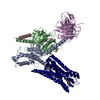
|
|---|---|
| 1 |
|
- Components
Components
-Guanine nucleotide-binding protein ... , 3 types, 3 molecules ABC
| #2: Protein | Mass: 40414.047 Da / Num. of mol.: 1 Source method: isolated from a genetically manipulated source Source: (gene. exp.)  Homo sapiens (human) / Gene: GNAI1 / Production host: Homo sapiens (human) / Gene: GNAI1 / Production host:  |
|---|---|
| #3: Protein | Mass: 38146.707 Da / Num. of mol.: 1 Source method: isolated from a genetically manipulated source Source: (gene. exp.)  Homo sapiens (human) / Gene: GNB1 / Production host: Homo sapiens (human) / Gene: GNB1 / Production host:  |
| #4: Protein | Mass: 7861.143 Da / Num. of mol.: 1 Source method: isolated from a genetically manipulated source Source: (gene. exp.)  Homo sapiens (human) / Gene: GNG2 / Production host: Homo sapiens (human) / Gene: GNG2 / Production host:  |
-Protein / Antibody / Non-polymers , 3 types, 3 molecules RE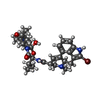

| #1: Protein | Mass: 67234.578 Da / Num. of mol.: 1 Source method: isolated from a genetically manipulated source Source: (gene. exp.)   Homo sapiens (human) Homo sapiens (human)Gene: cybC, DRD2 / Production host:  |
|---|---|
| #5: Antibody | Mass: 28813.047 Da / Num. of mol.: 1 Source method: isolated from a genetically manipulated source Source: (gene. exp.) synthetic construct (others) / Production host:  |
| #6: Chemical | ChemComp-08Y / |
-Details
| Has ligand of interest | Y |
|---|---|
| Has protein modification | Y |
-Experimental details
-Experiment
| Experiment | Method: ELECTRON MICROSCOPY |
|---|---|
| EM experiment | Aggregation state: PARTICLE / 3D reconstruction method: single particle reconstruction |
- Sample preparation
Sample preparation
| Component | Name: Bromocriptin-bound dopamine receptor 2 in complex with Gi protein Type: COMPLEX / Entity ID: #1-#5 / Source: RECOMBINANT |
|---|---|
| Source (natural) | Organism:  Homo sapiens (human) Homo sapiens (human) |
| Source (recombinant) | Organism:  |
| Buffer solution | pH: 7.2 |
| Specimen | Embedding applied: NO / Shadowing applied: NO / Staining applied: NO / Vitrification applied: YES |
| Vitrification | Cryogen name: ETHANE |
- Electron microscopy imaging
Electron microscopy imaging
| Experimental equipment |  Model: Titan Krios / Image courtesy: FEI Company |
|---|---|
| Microscopy | Model: FEI TITAN KRIOS |
| Electron gun | Electron source:  FIELD EMISSION GUN / Accelerating voltage: 300 kV / Illumination mode: FLOOD BEAM FIELD EMISSION GUN / Accelerating voltage: 300 kV / Illumination mode: FLOOD BEAM |
| Electron lens | Mode: BRIGHT FIELD |
| Image recording | Electron dose: 64 e/Å2 / Film or detector model: GATAN K2 BASE (4k x 4k) |
- Processing
Processing
| Software | Name: PHENIX / Version: 1.13_2998: / Classification: refinement |
|---|---|
| EM software | Name: PHENIX / Category: model refinement |
| CTF correction | Type: NONE |
| 3D reconstruction | Resolution: 2.8 Å / Resolution method: FSC 0.143 CUT-OFF / Num. of particles: 632558 / Symmetry type: POINT |
 Movie
Movie Controller
Controller





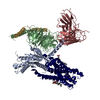

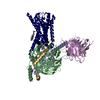
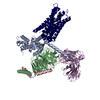
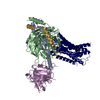
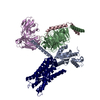
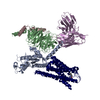
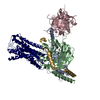

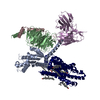
 PDBj
PDBj
